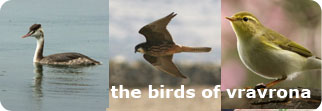|
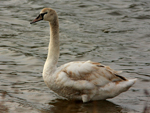 Mute Swan Cygnus olor
Mute Swan Cygnus olor
Winter visitor It has become quite regular in the last few years. Small group of up to 6 birds are usually seen in January and February.
|
|
 Common Shelduck Tadorna tadorna
Common Shelduck Tadorna tadorna
Winter visitor Rare winter visitor, and almost all records refer to just one bird.
|
|
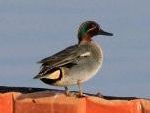 Eurasian Teal Anas crecca
Eurasian Teal Anas crecca
Winter visitor Regular winter visitor, up to 40 birds can be seen every year in the seasonal pool in front of the museum or the flooded areas of the coastal zone.
|
|
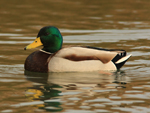 Mallard Anas platyrhynchos
Mallard Anas platyrhynchos
Winter visitor Regular winter visitor, up to 10 birds have been recorded at the seasonal pool in front of the museum. At least one pair breeds when water is retained until summer in the wetland.
|
|
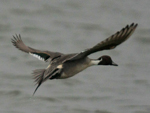 Northern Pintail Anas acuta
Northern Pintail Anas acuta
Winter visitor As with all other ducks, there are very few records of single individuals.
|
|
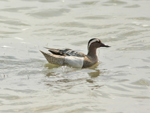 Garganey Anas querquedula
Garganey Anas querquedula
Passage migrant In spring, where large part of the area is flooded, small flocks (up to 10 individuals), while in fall where the area is dry it hasn’t been recorded at all.
|
|
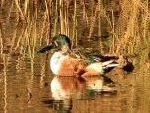 Northern Shoveler Anas clypeata
Northern Shoveler Anas clypeata
Winter visitor Rare visitor, singles or 1-2 pairs have been recorded in the seasonal pond in front of the Museum.
|
|
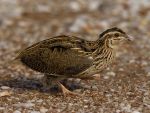 Common Quail Coturnix coturnix
Common Quail Coturnix coturnix
Passage migrant A very secretive species, stays hidden in lush vegetation, flushed always at the very last minute, and flying away with rapid wingbeats. It is recorded in spring and fall, mainly in the nearby Papoutsi and Pyrgari Hills.
|
|
 Little Grebe Tachybaptus ruficollis
Little Grebe Tachybaptus ruficollis
Winter visitor Seen in small numbers (up to 3 individuals) from late autumn to early spring. It is also an occasional breeder.
|
|
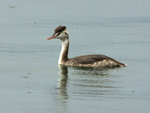 Great Crested Grebe Podiceps cristatus
Great Crested Grebe Podiceps cristatus
Winter visitor A scarce visitor, found always in the coastal zone.
|
|
 Black-necked Grebe Podiceps nigricollis
Black-necked Grebe Podiceps nigricollis
Winter visitor It is recorded in late fall and winter in the coastal zone.
|
|
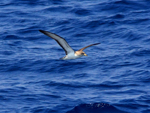 Cory’s Shearwater Calonectris diomedea
Cory’s Shearwater Calonectris diomedea
Non-breeding visitor 79/409 Directive, Annex I Cory's Shearwaters can be seen flying low in the open sea, from spring to fall.
|
|
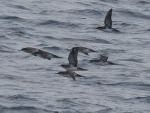 Yelkouan Shearwater Puffinus yelkouan
Yelkouan Shearwater Puffinus yelkouan
Non-breeding visitor Flocks of up to c.300 birds can be seen along the coast, feeding on schools of fish.
|
|
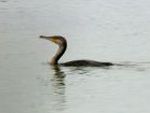 Great Cormorant Phalacrocorax carbo
Great Cormorant Phalacrocorax carbo
Winter visitor 79/409 Directive, Annex I Singles or small groups of up to 10 birds are frequently recorded in the coastal zone.
|
|
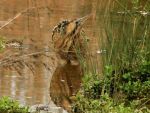 Eurasian Bittern Botaurus stellaris
Eurasian Bittern Botaurus stellaris
Accidental 79/409 Directive, Annex I It was first recorded in March, 2011.
|
|
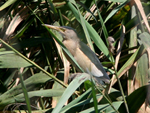 Little Bittern Ixobrychus minutus
Little Bittern Ixobrychus minutus
Passage migrant 79/409 Directive, Annex I Little Bitterns are a common sight in April and May, in the reeds along Erasinos. The species is scarce in fall and can be recorded till late October.
|
|
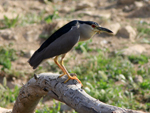 Black-crowned Night Heron Nycticorax nycticorax
Black-crowned Night Heron Nycticorax nycticorax
Passage migrant 79/409 Directive, Annex I Recorded mainly in spring, from late April to late May. It prefers Erasinos banks, often roosting in trees.
|
|
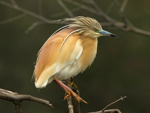 Squacco Heron Ardeola ralloides
Squacco Heron Ardeola ralloides
Passage migrant 79/409 Directive, Annex I Regular spring migrant, mainly in April and May. It can be seen everywhere, from the flooded areas of the coast to the riparian stands of Erasinos. Solitary individuals can also be seen in summer.
|
|
 Little Egret Egretta garzetta
Little Egret Egretta garzetta
Resident 79/409 Directive, Annex I Though not a "true" resident, the Little Egret can be found all year round. It's more common in spring, where flocks of 10-20 birds are seen, while 2-3 birds overwinter. It has been also recorded in summer (21/6/2008, 1 ind.).
|
|
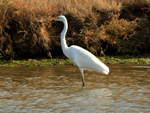 Great Egret Egretta alba
Great Egret Egretta alba
Winter visitor 79/409 Directive, Annex I One individual is recorded almost every winter, during the last years. It can also be recorded during migration, especially in spring, always close to the coast.
|
|
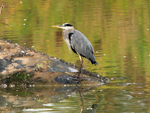 Grey Heron Ardea cinerea
Grey Heron Ardea cinerea
Resident Like the Little Egret, it can be recorded all year long, in smaller numbers. It is usually found in the coastal zone, using for roosting large trees and rocks.
|
|
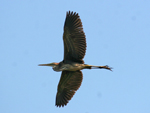 Purple Heron Ardea purpurea
Purple Heron Ardea purpurea
Passage migrant 79/409 Directive, Annex I Typical species of the reedbeds, it is recorded in spring, from mid April to late May.
|
|
 White Stork Ciconia ciconia
White Stork Ciconia ciconia
Passage migrant 79/409 Directive, Annex I A species that’s hard to see. Most observations refer to overflying flocks, from August to September.
|
|
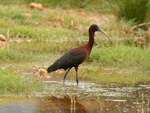 Glossy Ibis Plegadis falcinellus
Glossy Ibis Plegadis falcinellus
Passage migrant 79/409 Directive, Annex I It is found in wet meadows and flooded fields, therefore it is usually recorded in spring.
|
|
 Eurasian Spoonbill Platalea leucorodia
Eurasian Spoonbill Platalea leucorodia
Accidental 79/409 Directive, Annex I It has been recorded very few times in the past.
|
|
 Greater Flamingo Phoenicopterus roseus
Greater Flamingo Phoenicopterus roseus
Accidental 79/409 Directive, Annex I In 2009 a juvenile bird was found exhausted in the coastal zone.
|
|
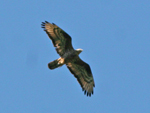 European Honey Buzzard Pernis apivorus
European Honey Buzzard Pernis apivorus
Passage migrant 79/409 Directive, Annex I It is recorded during both migration periods, single birds flying over the area.
|
|
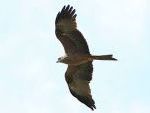 Black Kite Milvus migrans
Black Kite Milvus migrans
Passage migrant 79/409 Directive, Annex I A very rare visitor, has been recorded very few times so far.
|
|
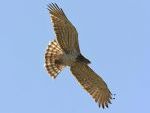 Short-toed Snake Eagle Circaetus gallicus
Short-toed Snake Eagle Circaetus gallicus
Summer visitor 79/409 Directive, Annex I A regular visitor to the area, during migration and in the summer, where birds nesting in adjacent areas forage for food. It prefers the open areas of Pirgari-Papoutsi hills.
|
|
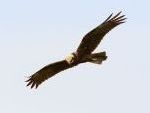 Western Marsh Harrier Circus aeruginosus
Western Marsh Harrier Circus aeruginosus
Winter visitor 79/409 Directive, Annex I An irregular visitor, it freqquents flooded areas and reedbeds. It is also recorded during migration.
|
|
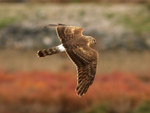 Northern Harrier Circus cyaneus
Northern Harrier Circus cyaneus
Winter visitor 79/409 Directive, Annex I An irregular visitor, like the Marsh Harrier. 1-2 birds are usually seen. It is also recorded during migration.
|
|
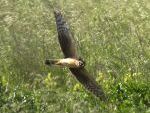 Pallid Harrier Circus macrourus
Pallid Harrier Circus macrourus
Passage migrant 79/409 Directive, Annex I It prefers cultivations, flying low in search of small birds and mammals.
|
|
 Montagu's Harrier Circus pygargus
Montagu's Harrier Circus pygargus
Passage migrant 79/409 Directive, Annex I More common in spring than autumn, it is most usually seen flying over.
|
|
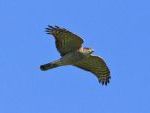 Eurasian Sparrowhawk Accipiter nisus
Eurasian Sparrowhawk Accipiter nisus
Winter visitor Very common in winter, taking advantage of the abundant food (small and medium sized birds). It can be also observed during migration, while there are a few records in summer.
|
|
 Common Buzzard Buteo buteo
Common Buzzard Buteo buteo
Resident Very common winter visitor. In the summer, birds from adjacent areas are frequently seen foraging.
|
|
 Long-legged Buzzard Buteo rufinus
Long-legged Buzzard Buteo rufinus
Resident, breeding 79/409 Directive, Annex I It is recorded all year long. At least one pair nests in the area (most probably in the nearby Perati Hill). It preys on reptiles and small mammals.
|
|
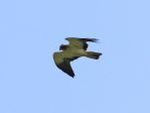 Booted Eagle Aquila pennata
Booted Eagle Aquila pennata
Passage migrant 79/409 Directive, Annex I A species becoming scarce in Greece, the Booted Eagle is rarely recorded during migration.
|
|
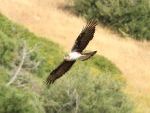 Bonelli's Eagle Aquila fasciata
Bonelli's Eagle Aquila fasciata
Accidental 79/409 Directive, Annex I The first record for the species was in 2006, where a juvenile was seen attacking Magpies.
|
|
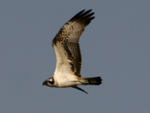 Osprey Pandion haliaetus
Osprey Pandion haliaetus
Accidental 79/409 Directive, Annex I It has been recorded very few times during migration.
|
|
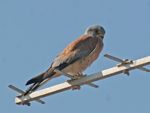 Lesser Kestrel Falco naumanni
Lesser Kestrel Falco naumanni
Passage migrant 79/409 Directive, Annex I It is recorded mainly in spring, almost always in fields. Most records refer to individuals or small groups of 3-5 birds.
|
|
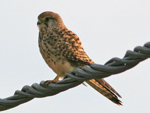 Common Kestrel Falco tinnunculus
Common Kestrel Falco tinnunculus
Resident, breeding The most common bird of prey. It nests in rocks and feeds on small mammals, reptiles and insects.
|
|
 Red-footed Falcon Falco vespertinus
Red-footed Falcon Falco vespertinus
Passage migrant 79/409 Directive, Annex I Quite common spring migrant, from mid April to late May, seen usually in small flocks. In autumn it is less common and only individuals are recorded. It is always seen in fields, feeding on insects.
|
|
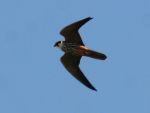 Eurasian Hobby Falco subbuteo
Eurasian Hobby Falco subbuteo
Passage migrant 79/409 Directive, Annex I First record, April 2013, flying among a flock of swallows. Fast and agile, it is very difficult to be seen.
|
|
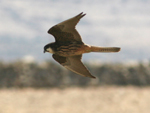 Eleonora's Falcon Falco eleonorae
Eleonora's Falcon Falco eleonorae
Non breeding visitor 79/409 Directive, Annex I In spring and early summer, Eleonora's Falcons can be seen flying over the area, looking for large insects.
|
|
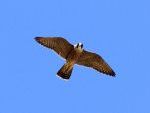 Peregrine Falcon Falco peregrinus
Peregrine Falcon Falco peregrinus
Resident, breeding 79/409 Directive, Annex I Peregrines can be seen year round, searching for prey. In the wider area there is a nesting pair, while more birds arrive in winter.
|
|
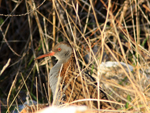 Water Rail Rallus aquaticus
Water Rail Rallus aquaticus
Resident, breeding Hard to see but very easy to hear due to its characteristic pig-like calls. It nests in reedbeds along Erasinos river in small numbers.
|
|
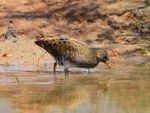 Spotted Crake Porzana porzana
Spotted Crake Porzana porzana
Passage migrant A very hard to see species that feeds almost exclusively very close to dense vegetation, avoiding open water. It can be seen along Erasinos River, mainly in spring and rarely in autumn.
|
|
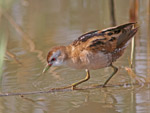 Little Crake Porzana parva
Little Crake Porzana parva
Passage migrant 79/409 Directive, Annex I A species that prefers the safety of reeds and lush vegetation, therefore evading tracking. Nevertheless, it is a regular spring migrant, while it has also been recorded in summer.
|
|
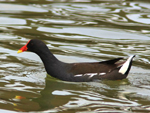 Common Moorhen Gallinula chloropus
Common Moorhen Gallinula chloropus
Resident, breeding A common resident along Erasinos river, it can be even seen in flooded fields, as long as there's no disturbance.
|
|
 Eurasian Coot Fulica atra
Eurasian Coot Fulica atra
Winter visitor Common and regular, seen in the estuary of Erasinos River or the seasonal pool in front of the Museum.
|
|
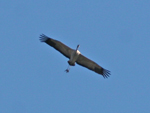 Common Crane Grus grus
Common Crane Grus grus
Rare passage migrant 79/409 Directive, Annex I Very few times have Cranes been observed in the area. All the records are of individuals or small overflying flocks.
|
|
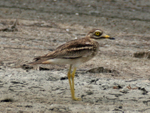 Eurasian Stone-curlew Burhinus oedicnemus
Eurasian Stone-curlew Burhinus oedicnemus
Rare passage migrant 79/409 Directive, Annex I A very scarce visitor, susceptible to disturbance with very few records. Quite recently the species was reported as breeding near the new airport. Under certain circumstances there could be a chance of breeding also in Vravrona.
|
|
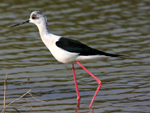 Black-winged Stilt Himantopus himantopus
Black-winged Stilt Himantopus himantopus
Passage migrant 79/409 Directive, Annex I A common spring visitor, small groups can be seen from March already. It prefers wet meadows and flooded areas in the coast.
|
|
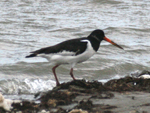 Eurasian Oystercatcher Haematopus ostralegus
Eurasian Oystercatcher Haematopus ostralegus
Passage migrant Oystercatchers may be seen only in the coastal zone.
|
|
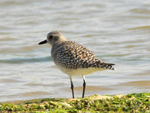 Grey Plover Pluvialis squatarola
Grey Plover Pluvialis squatarola
Passage migrant Solitary birds are observed in the coastal zone, especially when the tide is low.
|
|
 Northern Lapwing Vanellus vanellus
Northern Lapwing Vanellus vanellus
Rare winter visitor Nowadays it is a very rare winter visitor, not seen every year. All the recent records are of solitary birds in wet meadows or flooded fields.
|
|
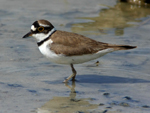 Little Ringed Plover Charadrius dubius
Little Ringed Plover Charadrius dubius
Summer visitor, breeding One pair is nesting every year in the coastal zone. During migration, groups of up to 30 birds can be seen.
|
|
 Common Ringed Plover Charadrius hiaticula
Common Ringed Plover Charadrius hiaticula
Passage migrant Much less common than Little Ringed Plover, it is found in the same habitats in much smaller numbers and not so frequently.
|
|
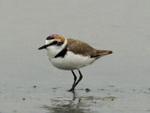 Kentish Plover Charadrius alexandrinus
Kentish Plover Charadrius alexandrinus
Passage migrant A species that could also nest, should there wasn't so much disturbance in the coastal zone. For the time being, it is recorded only during migration.
|
|
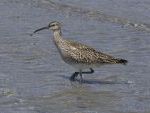 Whimbrel Numenius phaeopus
Whimbrel Numenius phaeopus
Accidental First recorded in April 2014, in the coastal zone.
|
|
 Eurasian Curlew Numenius arquata
Eurasian Curlew Numenius arquata
Passage migrant Bird of brackish and salt water, seen always in the coastal zone in spring, in small groups of up to 4 birds.
|
|
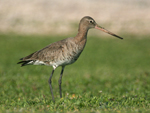 Black-tailed Godwit Limosa limosa
Black-tailed Godwit Limosa limosa
Passage migrant Rare spring visitor, found in the coastal zone and the shallow brackish waters near the estuary.
|
|
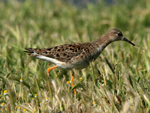 Ruff Calidris pugnax
Ruff Calidris pugnax
Passage migrant 79/409 Directive, Annex I One of the earliest spring migrants, from March already. Apart from the coastal zone, it can be seen in flloded cultivations.
|
|
 Curlew Sandpiper Calidris ferruginea
Curlew Sandpiper Calidris ferruginea
Passage migrant The most common stint from late April to mid May. Always found in the coastal zone, autumn records are very few.
|
|
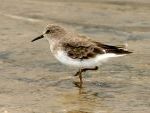 Temminck’s Stint Calidris temminckii
Temminck’s Stint Calidris temminckii
Accidental It was first recorded in April 2014, in a flooded field.
|
|
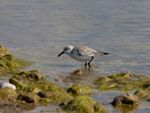 Sanderling Calidris alba
Sanderling Calidris alba
Passage migrant Rare spring visitor, alwasy seen along with other Calidris spp.
|
|
 Dunlin Calidris alpina
Dunlin Calidris alpina
Passage migrant Seen with Little Stints in spring. Autumn records are very few.
|
|
 Little Stint Calidris minuta
Little Stint Calidris minuta
Passage migrant Small groups can be seen in spring in the coastal zone, while autumn observations are very few, as the are is dry.
|
|
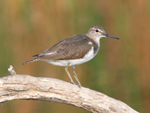 Common Sandpiper Actitis hypoleucos
Common Sandpiper Actitis hypoleucos
Passage migrant A common sight during both migration periods in the coastal zone. It is very possible that some birds may overwinter.
|
|
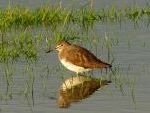 Green Sandpiper Tringa ochropus
Green Sandpiper Tringa ochropus
Passage migrant, winter visitor One of the few waders that overwinter in the area. In the spring it's more common and small groups can be observed wherever there's water
|
|
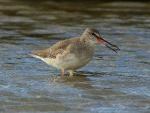 Spotted Redshank Tringa erythropus
Spotted Redshank Tringa erythropus
Passage migrant Rare migrant, recorded only in the coastal zone.
|
|
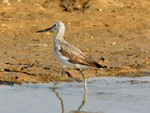 Common Greenshank Tringa nebularia
Common Greenshank Tringa nebularia
Passage migrant Like the Marsh Sandpiper, it can be seen along with other waders in wet meadows and the coastal zone.
|
|
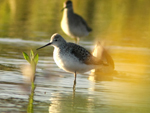 Marsh Sandpiper Tringa stagnatilis
Marsh Sandpiper Tringa stagnatilis
Passage migrant A spring visitor, recorded singly along with other waders in wet meadows and the coastal zone.
|
|
 Wood Sandpiper Tringa glareola
Wood Sandpiper Tringa glareola
Passage migrant 79/409 Directive, Annex I Probably the most common wader that can be seen in spring. Autumn records are much fewer.
|
|
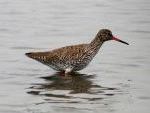 Common Redshank Tringa totanus
Common Redshank Tringa totanus
Passage migrant One of the most common waders, can be seen in everywhere near fresh water.
|
|
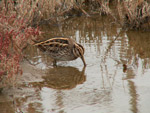 Jack Snipe Lymnocryptes minimus
Jack Snipe Lymnocryptes minimus
Winter visitor Rare winter visitor, very hard to see as it prefers staying still until the very last moment, usually one step before being stepped over.
|
|
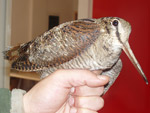 Eurasian Woodcock Scolopax rusticola
Eurasian Woodcock Scolopax rusticola
Winter visitor Very hard to see, and not coming every winter. Its presence depends on the severity of winter.
|
|
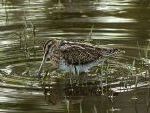 Common Snipe Gallinago gallinago
Common Snipe Gallinago gallinago
Passage migrant, winter visitor The most common snipe, often recorded in winter and during migration.
|
|
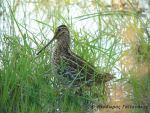 Great Snipe Gallinago media
Great Snipe Gallinago media
Accidental First recorded in April 2014, in a flooded field.
|
|
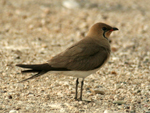 Collared Pratincole Glareola pratincola
Collared Pratincole Glareola pratincola
Passage migrant 79/409 Directive, Annex I Suitable habitats are very few in the area, therefore it is very scarce.
|
|
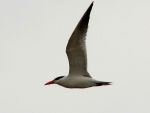 Caspian Tern Hydroprogne caspia
Caspian Tern Hydroprogne caspia
Accidental A bird was found exhausted in the coastal zone, in August 2014.
|
|
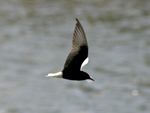 White-winged Tern Chlidonias leucopterus
White-winged Tern Chlidonias leucopterus
Passage migrant This tern prefers fresh water, therefore can be seen only in spring in flooded areas, feeding on insects.
|
|
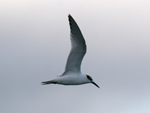 Sandwich Tern Sterna sandvicensis
Sandwich Tern Sterna sandvicensis
Winter visitor 79/409 Directive, Annex I Regular visitor, up to five birds can be seen at the same time in the shallow waters of Vravrona bay. Birds remain till April.
|
|
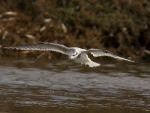 Little Gull Hydrocoloeus minutus
Little Gull Hydrocoloeus minutus
Winter visitor Rare visitor, seen mostly singly in the coastal zone.
|
|
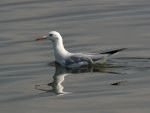 Slender-billed Gull Larus genei
Slender-billed Gull Larus genei
Winter visitor 79/409 Directive, Annex I
Rare and irregular, seen exclustively in the coastal zone.
|
|
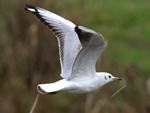 Black-headed Gull Larus ridibundus
Black-headed Gull Larus ridibundus
Winter visitor Very common in winter, it can be easily seen in the coast. It is present from late fall to early April, although single birds can be seen almost year round.
|
|
 Audouin's Gull Larus audouinii
Audouin's Gull Larus audouinii
Winter Visitor 79/409 Directive, Annex I
Very rare sight in the area and eastern Attica in general. First seen on February 2012.
|
|
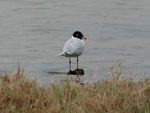 Mediterranean Gull Larus melanocephalus
Mediterranean Gull Larus melanocephalus
Winter visitor 79/409 Directive, Annex I An irregular winter visitor, coming in small numbers. January and February are the best months to see it.
|
|
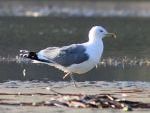 Caspian Gull Larus cachinnans
Caspian Gull Larus cachinnans
Winter Visitor
Regular visitor that's usually overlooked among the much more common Yellow-legged Gulls.
|
|
 Yellow-legged Gull Larus michahellis
Yellow-legged Gull Larus michahellis
Resident The most common gull, can be seen everywhere: from the coastal zone to the cultivated fields, taking advantage of all the available food resources.
|
|
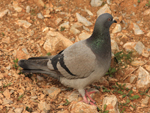 Rock Dove Columba livia
Rock Dove Columba livia
Resident, breeding Flocks of birds that nest in nearby rocky islets fly over the area daily. All the birds seen foraging inside the wetland are Feral Pigeons (Columba livia domesticus).
|
|
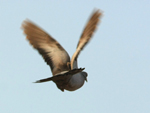 Stock Dove Columba oenas
Stock Dove Columba oenas
Passage migrant Flocks of Stock Doves are usually seen in autumn. They're very hard to see, being always on the move.
|
|
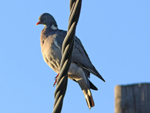 Common Wood Pigeon Columba palumbus
Common Wood Pigeon Columba palumbus
Winter visitor Very rare and irregular winter visitor, its presence depends on the severity of winter. It prefers cultivations and roosts in the wooded hills.
|
|
 Eurasian Collared Dove Streptopelia decaocto
Eurasian Collared Dove Streptopelia decaocto
Resident, breeding Found always near man, this dove can be seen near cultivations and human installations.
|
|
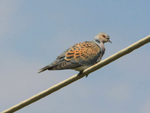 European Turtle Dove Streptopelia turtur
European Turtle Dove Streptopelia turtur
Summer visitor, breeding A favorite quarry in fall (and unfortunately, for some in spring), the Turtle Dove arrives in late April, and preferes orchards and wooded hills. A small number (<10 p.) nests.
|
|
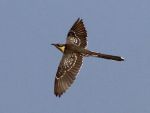 Great Spotted Cuckoo Clamator glandarius
Great Spotted Cuckoo Clamator glandarius
Summer visitor In 2012, the first successful breeding attempt was recorded. The great density of Magpie nests in the area is a magnet for this species, therefore it is expected to have a more regular presence in the future.
|
|
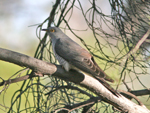 Common Cuckoo Cuculus canorus
Common Cuckoo Cuculus canorus
Passage migrant Its distinctive call can be heard from late March in spring. In autumn is much less common. It can be found in orchards or pine woodland.
|
|
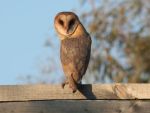 Barn Owl Tyto alba
Barn Owl Tyto alba
Resident, breeding A typical nocturnal bird, very rarely seen. The least common of the owls breeding, feeds mainly on rodents and other small mammals.
|
|
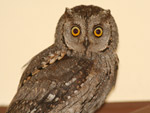 Eurasian Scops Owl Otus scops
Eurasian Scops Owl Otus scops
Summer visitor, breeding Its call, along with the Nightingale's song are the most characteristic sounds of the summer nights. Very hard to see, perching always on large trees.
|
|
 Little Owl Athene noctua
Little Owl Athene noctua
Resident, breeding Easy to see, as it has diurnal habits, in rocks. Feeds on large insects and smal mammals.
|
|
 Tawny Owl Strix aluco
Tawny Owl Strix aluco
Resident (?), breeding (?) Recorded in the past, no recent observations made. However, it’s very likely that at least one pair nests in the area. It feeds on small mammals, birds, nesting in rock crevices or holes in trees.
|
|
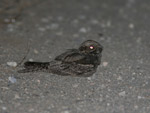 European Nightjar Caprimulgus europaeus
European Nightjar Caprimulgus europaeus
Summer visitor, breeding 79/409 Directive, Annex I Common in the surrounding hills. It’s plain, cricket-like, song can be heard easily in May and June.
|
|
 Common Swift Apus apus
Common Swift Apus apus
Summer visitor, breeding Swifts are common visitors, hunting insects above the cultivated land or the wetland. A small number nests in buildings in or around the area.
|
|
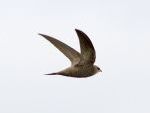 Pallid Swift Apus pallidus
Pallid Swift Apus pallidus
Summer visitor It can be seen, along with Swifts and Alpine Swifts, flying above the area, looking for flying insects.
|
|
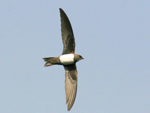 Alpine Swift Apus melba
Alpine Swift Apus melba
Summer visitor From April to October, Alpine Swifts visit the area for feeding and drinking.
|
|
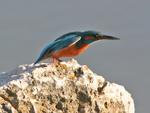 Common Kingfisher Alcedo atthis
Common Kingfisher Alcedo atthis
Winter visitor 79/409 Directive, Annex I Hard to miss in winter, birds are usually seen sitting in branches or reeds along Erasinos river and its estuary. It feeds on small fish and insects. Its presence may extend from July to late March.
|
|
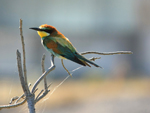 European Bee-eater Merops apiaster
European Bee-eater Merops apiaster
Passage migrant Flocks of passing Bee-eaters are recorded from mid April to late May, with most records in mid May. It is less common in autumn.
|
|
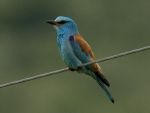 European Roller Coracias garrulus
European Roller Coracias garrulus
Accidental First recorded in April 2014.
|
|
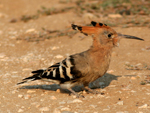 Hoopoe Upupa epops
Hoopoe Upupa epops
Summer visitor, breeding An early comer, some birds appearing in late February, the Hoopoe is one of the species that have showed increase in their population. It nests on tree hollows and rock crevices. It's usually seen in fields looking for insects and caterpillars.
|
|
 Eurasian Wryneck Jynx torquilla
Eurasian Wryneck Jynx torquilla
Passage migrant Secretive, very hard to see or hear. It prefers densely vegetated areas.
|
|
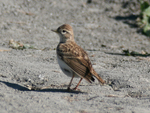 Greater Short-toed Lark Calandrella brachydactyla
Greater Short-toed Lark Calandrella brachydactyla
Summer visitor, breeding 79/409 Directive, Annex I An inhabitant of spasely vegetated ares, this lark breeds in odd pairs in the vineyards. It's threatened by conversion of agriculutural land by the extensive use of agrochemicals.
|
|
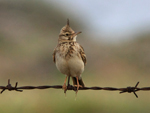 Crested Lark Galerida cristata
Crested Lark Galerida cristata
Resident, breeding Probably the most common agricultural bird, it can be seen in fields, garrigue and other open areas.
|
|
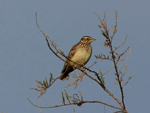 Woodlark Lullula arborea
Woodlark Lullula arborea
Winter visitor 79/409 Directive, Annex I From November to March, small groups can be observed in fields and other open areas with scattered bushes and trees.
|
|
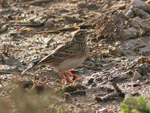 Eurasian Skylark Alauda arvensis
Eurasian Skylark Alauda arvensis
Winter visitor Very common in winter, flocks can be seen in field from November to February. It's one of the most favorite, along with the thrushes, quarry.
|
|
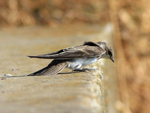 Sand Martin Riparia riparia
Sand Martin Riparia riparia
Passage migrant The most typical wetland swallow is a regular visitor to Vravrona. It is often seen along with other species, hunting insects above the wetland.
|
|
Eurasian Crag Martin Ptyonoprogne rupestris
Accidental
|
|
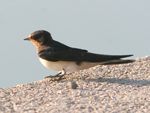 Barn Swallow Hirundo rustica
Barn Swallow Hirundo rustica
Summer visitor, breeding The most numerous hirundine, arrives in March and departs in September. Many pairs nest in building, while significant numbers roost in the reeds during migration.
|
|
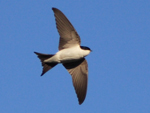 Common House Martin Delichon urbicum
Common House Martin Delichon urbicum
Summer visitor, breeding It nests almost exclusivel in towns and villages. Vravrona is very important feeding and mud collecting area.
|
|
 Red-rumped Swallow Cecropis daurica
Red-rumped Swallow Cecropis daurica
Summer visitor, breeding Less familiar with man, prefers natural areas. In Vravrona, can be also seen in abandoned buildings.
|
|
 Tawny Pipit Anthus campestris
Tawny Pipit Anthus campestris
Passage migrant 79/409 Directive, Annex I An open area bird, can be found from coastal zones to alpine meadows! Has been recorded during migration in spring and autumn.
|
|
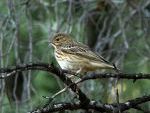 Tree Pipit Anthus trivialis
Tree Pipit Anthus trivialis
Passage migrant Found wherever there are large bushes and trees. Is more easily seen in spring than in autumn.
|
|
 Meadow Pipit Anthus pratensis
Meadow Pipit Anthus pratensis
Winter visitor The most common pipit, can be found everywhere in winter: From the coast to the cultivated fields and phrygana. Recorded from October to early April.
|
|
 Red-throated Pipit Anthus cervinus
Red-throated Pipit Anthus cervinus
Passage migrant Rare visitor, seen always in the cultivations adjacent to Erasinos river.
|
|
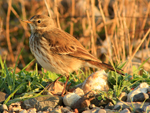 Water Pipit Anthus spinoletta
Water Pipit Anthus spinoletta
Winter visitor Less common than Meadow Pipit, is usually seen in small groups of 2-3 birds. Recorded from November to March.
|
|
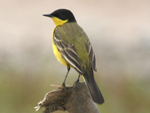 Yellow Wagtail Motacilla flava
Yellow Wagtail Motacilla flava
Passage migrant Very common during migration, flocks of 30-40 birds can be seen in flooded areas and cultivations, especially in autumn. Many different subspecies have been recorded, most common being M.f.feldegg and M.f.flava.
|
|
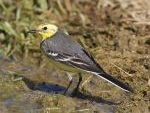 Citrine Wagtail Motacilla citreola
Citrine Wagtail Motacilla citreola
Accidental First record for this rare visitor of Attica, a bird seen in Erasinos River, May 2013.
|
|
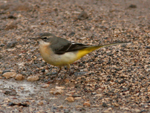 Grey Wagtail Motacilla cinerea
Grey Wagtail Motacilla cinerea
Winter visitor A common visitor of the banks of Erasinos. Recorded from September to April, even though it is also seen in late July!
|
|
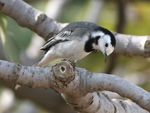 White Wagtail Motacilla alba
White Wagtail Motacilla alba
Winter visitor Very common in winter, in cultivated areas and the coastal zone. Seen from September to April.
|
|
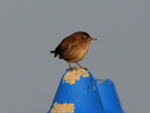 Winter Wren Troglodytes troglodytes
Winter Wren Troglodytes troglodytes
Winter visitor One of the smallest birds of Europe, has a very loud song that can be heard even in the heart of winter. It is found in densely vegetated areas.
|
|
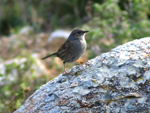 Dunnock Prunella modularis
Dunnock Prunella modularis
Winter visitor A typical bushland bird, always staying hidden. Recorded from October to late March or early April.
|
|
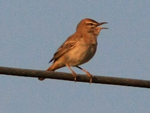 Rufous-tailed Scrub Robin Cercotrichas galactotes
Rufous-tailed Scrub Robin Cercotrichas galactotes
Summer visitor, breeding A drastic decline of its population has been noticed, it is now found breeding only in the area close to the springs of Erasinos river.
|
|
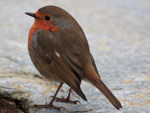 European Robin Erithacus rubecula
European Robin Erithacus rubecula
Winter visitor Abundant in winter, can be seen everywhere. Recorded from late August to early May.
|
|
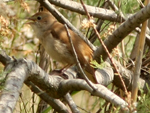 Common Nightingale Luscinia megarhynchos
Common Nightingale Luscinia megarhynchos
Summer visitor, breeding Its song can be heard from dense bushes in spring. It is mainly seen in April. Autumn passage is virtually undetectable.
|
|
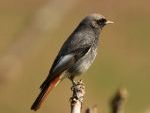 Black Redstart Phoenicurus ochruros
Black Redstart Phoenicurus ochruros
Winter visitor A typical rock-loving bird, is usually seen perching on stones, rocks and buildings. Arrives in October and departs in March-early April.
|
|
 Common Redstart Phoenicurus phoenicurus
Common Redstart Phoenicurus phoenicurus
Passage migrant. Not a very common visitor in Vravrona. Seen in woodland and orchards.
|
|
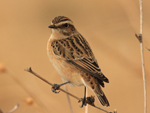 Whinchat Saxicola rubetra
Whinchat Saxicola rubetra
Passage migrant A very common migrant, seen everywhere: cultivations, scrub, inside the wetland, etc.
|
|
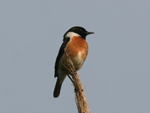 Common Stonechat Saxicola rubicola
Common Stonechat Saxicola rubicola
Resident, breeding A typical scrub bird, is easily seen in the surrounding hills. Many times is also seen inside the wetland and the cultivations.
|
|
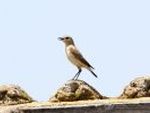 Isabelline Wheatear Oenanthe isabellina
Isabelline Wheatear Oenanthe isabellina
Passage migrant Very rare visitor, has been recorded few times so far.
|
|
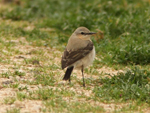 Northern Wheatear Oenanthe oenanthe
Northern Wheatear Oenanthe oenanthe
Passage migrant One of the most common autumn migrants. It can be seen everywhere, from scrub to cultivations, even in the margins of the wetland. In spring it is recorded in smaller numbers.
|
|
 Black-eared Wheatear Oenanthe hispanica
Black-eared Wheatear Oenanthe hispanica
Summer visitor, breeding A typical rock and scrub-loving bird, in nests in the asjacent hills. Recorded from late March to late August.
|
|
Common Rock Thrush Monticola saxatilis
Accidental First recorded in September 2014.
|
|
 Blue Rock Thrush Monticola solitarius
Blue Rock Thrush Monticola solitarius
Winter visitor In winter, we can see it in rocky outcrops and steep slopes. Arrives in November and departs in March.
|
|
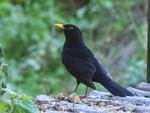 Common Blackbird Turdus merula
Common Blackbird Turdus merula
Resident, breeding Breeding Blackbirds are found in well wooded patches. In winter, they can be seen everywhere, as birds from the north join locals.
|
|
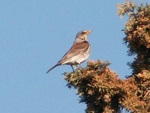 Fieldfare Turdus pilaris
Fieldfare Turdus pilaris
Winter visitor Not very common and irregular, its presence varies each year. Prefers orchards and scrub.
|
|
 Song Thrush Turdus philomelos
Song Thrush Turdus philomelos
Winter visitor The most common thrush, can be seen in large numbers. Favorite quarry, is recorded from October to March.
|
|
Redwing Turdus iliacus
Winter visitor Rare visitor, not recorded every year.
|
|
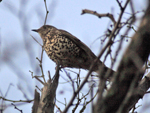 Mistle Thrush Turdus viscivorus
Mistle Thrush Turdus viscivorus
Winter visitor A scarce and irregular winter visitor. Usually seen in orchards, pine woodland and tall maquis.
|
|
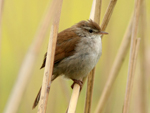 Cetti's Warbler Cettia cetti
Cetti's Warbler Cettia cetti
Resident, breeding Probably the most numerous breeding passerine of the wetland, nesting everywhere.
|
|
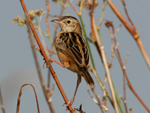 Zitting Cisticola Cisticola juncidis
Zitting Cisticola Cisticola juncidis
Resident, breeding A species with an unfavourable conservation status in Greece, still nesting in Vravrona. Found in open areas of the wetland and the margins of the cultivated areas.
|
|
 Savi's Warbler Locustella luscinioides
Savi's Warbler Locustella luscinioides
Passage migrant Very secretive visitor, with just a handful of records in spring.
|
|
 Eastern Olivaceous Warbler Iduna pallida
Eastern Olivaceous Warbler Iduna pallida
Summer visitor, breeding A very late visitor, from late April to early August. It nests in large numbers in tamarisks, pines and other trees.
|
|
 Olive-tree Warbler Hippolais olivetorum
Olive-tree Warbler Hippolais olivetorum
Summer visitor, breeding 79/409 Directive, Annex I Very rare visitor, hard to see. It nests in olive groves, tall maquis, preffering to remain hidden almost all the time.
|
|
 Icterine Warbler Hippolais icterina
Icterine Warbler Hippolais icterina
Passage migrant Hard to see, even though it's not rare. Recorded from mid April to early May, and August-September. Prefers wooded areas with trees and tall bushes.
|
|
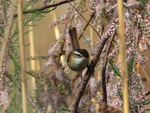 Moustached Warbler Acrocephalus melanopogon
Moustached Warbler Acrocephalus melanopogon
Winter visitor 79/409 Directive, Annex I Fairly common winter visitor, found in reeds, close to water. Recorded from November to April.
|
|
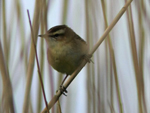 Sedge Warbler Acrocephalus schoenobaenus
Sedge Warbler Acrocephalus schoenobaenus
Passage migrant Fairly common spring visitor, especially in April. Found near reeds and other wetland plants. In autumn is much less common.
|
|
Marsh Warbler Acrocephalus palustris
Passage migrant Very hard to see as it prefers the safety of large bushes. Its song is full of mimicry.
|
|
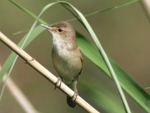 Eurasian Reed Warbler Acrocephalus scirpaceus
Eurasian Reed Warbler Acrocephalus scirpaceus
Summer visitor, breeding Very common summer breeder along Erasinos river. Recorded from April to September. During migration can be seen in more "dry" habitats like bushes and trees in cultivations.
|
|
 Great Reed Warbler Acrocephalus arundinaceus
Great Reed Warbler Acrocephalus arundinaceus
Summer visitor, breeding The largest warbler, with a frog-like song! It is found in reeds and large bushes and trees, even outside the wetland margins.
|
|
 Subalpine Warbler Sylvia cantillans
Subalpine Warbler Sylvia cantillans
Passage migrant A migrant recorded in spring and autumn, usually in scrub in and around the wetland.
|
|
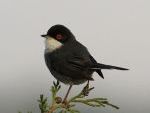 Sardinian Warbler Sylvia melanocephala
Sardinian Warbler Sylvia melanocephala
Resident, breeding Widespread and common, it is found everywhere.
|
|
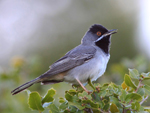 Rüppell's Warbler Sylvia rueppelli
Rüppell's Warbler Sylvia rueppelli
Passage migrant 79/409 Directive, Annex I Sping visitor, has not been recorded nesting yet, even though it could do so, as there are suitable habitats.
|
|
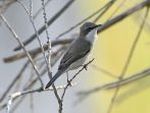 Lesser Whitethroat Sylvia curruca
Lesser Whitethroat Sylvia curruca
Passage migrant Albeit common, it is not easily seen as it is not very vocal in spring and its typical call is very similar to that of many other warblers. It frequents dense bushes and brambles.
|
|
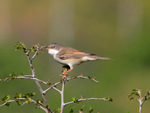 Common Whitethroat Sylvia communis
Common Whitethroat Sylvia communis
Passage migrant Regural migrant, April is the best month for recording it. Frequents tall maquis and trees.
|
|
 Garden Warbler Sylvia borin
Garden Warbler Sylvia borin
Passage migrant A featureless bird, passes unnoticed. Prefers "damp" areas with dense vegetation. May is the best month, while in autumn it can be seen feeding on figs.
|
|
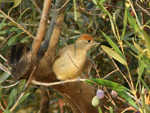 Eurasian Blackcap Sylvia atricapilla
Eurasian Blackcap Sylvia atricapilla
Winter visitor Very common and widespread, from August already passing birds can be seen. Abundant from October to March. Spring migration continues to May.
|
|
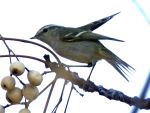 Yellow-browed Warbler Phylloscopus inornatus
Yellow-browed Warbler Phylloscopus inornatus
Accidental A bird was recorded from January to early April 2014.
|
|
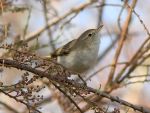 Eastern Bonelli’s Warbler Phylloscopus orientalis
Eastern Bonelli’s Warbler Phylloscopus orientalis
Migrant First recorded in March, 2011. A general increase on the observations around Attica has been noticed in the last few years, so more observations are expected.
|
|
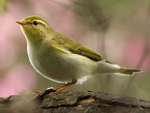 Wood Warbler Phylloscopus sibilatrix
Wood Warbler Phylloscopus sibilatrix
Passage migrant Common in spring, scarce in autumn, this Warbler frequents densely vegetated areas. Therefore, it is usually seen in pine stands, orchards and along Erasinos river, in tamarisks and other trees.
|
|
 Common Chiffchaff Phylloscopus collybita
Common Chiffchaff Phylloscopus collybita
Winter visitor The only wintering Phylloscopus warbler, is very common and widespread. It can be seen everywhere, from September to April.
|
|
 Willow Warbler Phylloscopus trochilus
Willow Warbler Phylloscopus trochilus
Passage migrant Very common in autumn, very rare in spring. Almost always found in open areas. August and September are the best months, while migration continues till October.
|
|
 Goldcrest Regulus regulus
Goldcrest Regulus regulus
Winter visitor Uncommon and irregular, the Goldcrest frequents only woodland. There are years that it's very common and others that none appears. When present, is seen from late September to late March,
|
|
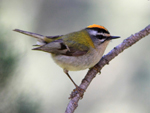 Common Firecrest Regulus ignicapilla
Common Firecrest Regulus ignicapilla
Winter visitor Regular winter visitor in pine woodland. From October to March it's always seen on the move, looking for insects and small arachnids.
|
|
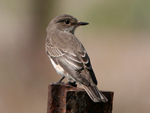 Spotted Flycatcher Muscicapa striata
Spotted Flycatcher Muscicapa striata
Summer visitor, breeding The only flycatcher nesting in the area, and the only common migrant in autumn. Arrives in April, and departs in September-October. Frequents in wooded areas.
|
|
 Collared Flycatcher Ficedula albicollis
Collared Flycatcher Ficedula albicollis
Passage migrant 79/409 Directive, Annex I Like all the other black and white flycatchers, very common spring visitor and rare in autumn. April is the best month to record this species.
|
|
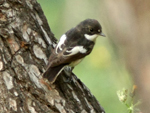 European Pied Flycatcher Ficedula hypoleuca
European Pied Flycatcher Ficedula hypoleuca
Passage migrant Very common in spring, much less common in autumn. April is the best month to see it.
|
|
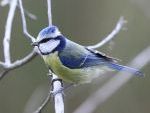 Eurasian Blue Tit Cyanistes caeruleus
Eurasian Blue Tit Cyanistes caeruleus
Winter visitor Scarce winter visitor. Found close to the wetland, in trees and large bushes.
|
|
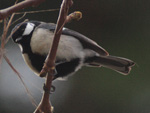 Great Tit Parus major
Great Tit Parus major
Resident, breeding Common and widespread, found everywhere. Inside the wetland, in the orchards and the bushy hills. More common in places with a lot of trees.
|
|
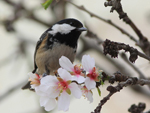 Coal Tit Periparus ater
Coal Tit Periparus ater
Winter visitor Uncommon winter visitor, found in small numbers in pine woodland. Seen from October to March.
|
|
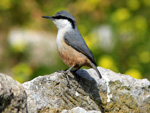 Western Rock Nuthatch Sitta neumayer
Western Rock Nuthatch Sitta neumayer
Extinct It was included in the past as breeding, however there hasn’t been any observation in the last few years.
|
|
 Short-toed Treecreeper Certhia brachydactyla
Short-toed Treecreeper Certhia brachydactyla
Winter visitor Typical pine forest dweller, in winter it can be seen in mature trees. Seen from October to March.
|
|
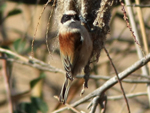 Eurasian Penduline Tit Remiz pendulinus
Eurasian Penduline Tit Remiz pendulinus
Resident, breeding A typical wetland tit, its nests are usually hanging from tamarisks. In winter, more birds from the north join the local population.
|
|
 Eurasian Golden Oriole Oriolus oriolus
Eurasian Golden Oriole Oriolus oriolus
Passage migrant Common but secretive, always seeking refuge in the dense foliage of trees and large bushes. Seen usually from late April to late May, while in autumn is very scarce.
|
|
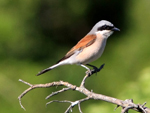 Red-backed Shrike Lanius collurio
Red-backed Shrike Lanius collurio
Passage migrant 79/409 Directive, Annex I Uncommon in spring, abundant and widespread in autumn. Arrives late in spring, usually early May, while in autumn is usually seen in September and October.
|
|
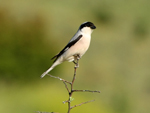 Lesser Grey Shrike Lanius minor
Lesser Grey Shrike Lanius minor
Passage migrant 79/409 Directive, Annex I The least common shrike, is usually seen in autumn. It frequents in open areas with scattered bushes.
|
|
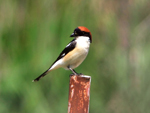 Woodchat Shrike Lanius senator
Woodchat Shrike Lanius senator
Summer visitor, breeding The only nesting shrike, also common during migration. A few pairs nest in the area, in large bushes.
|
|
 Eurasian Jay Garrulus glandarius
Eurasian Jay Garrulus glandarius
Accidental A small population has been established in Dedespoti Hill, north of the wetland.
|
|
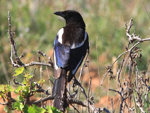 Common Magpie Pica pica
Common Magpie Pica pica
Resident, breeding The most common corvid in the area. Found everywhere, has benefited from human presence. Preys on small birds’ eggs and chicks.
|
|
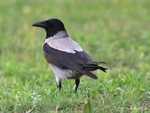 Hooded Crow Corvus corone
Hooded Crow Corvus corone
Resident, breeding A small number, not more than 4-5 birds, in seen all year round. Probably the high population of Magpies, prevents it from increasing its own population.
|
|
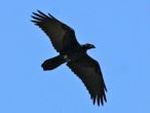 Northern Raven Corvus corax
Northern Raven Corvus corax
Non-breeding visitor A pair is regularly seen in the area, most probably nesting in an islet of south Evoikos gulf.
|
|
 Common Starling Sturnus vulgaris
Common Starling Sturnus vulgaris
Winter visitor Flocks of many thousands birds visit the area, because of the olive trees and the cultivations. Most birds have arrived by the end of Novemder, while spring departure begins in February.
|
|
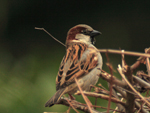 House Sparrow Passer domesticus
House Sparrow Passer domesticus
Resident, breeding Widespread and abundant, the House sparrow is one of the most common birds. Found wherever there's human presence.
|
|
 Spanish Sparrow Passer hispaniolensis
Spanish Sparrow Passer hispaniolensis
Winter visitor Groups of 10-20 birds are seen along with House Sparrows in the winter, in fields along Erasinos river. In spring and autumn there’s also a small passage.
|
|
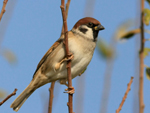 Eurasian Tree Sparrow Passer montanus
Eurasian Tree Sparrow Passer montanus
Resident, breeding Less common than the House Sparrow, a small number nests in trees in the cultivated areas.
|
|
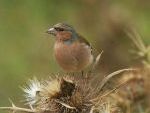 Common Chaffinch Fringilla coelebs
Common Chaffinch Fringilla coelebs
Winter visitor The most common finch in winter, large flocks are seen all over Vravrona. Recorded from September to April.
|
|
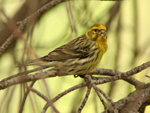 European Serin Serinus serinus
European Serin Serinus serinus
Resident, breeding In winter, flocks can be seen in cultivations along with other finches. In summer, a small numbers nests in conifers.
|
|
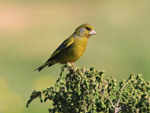 European Greenfinch Carduelis chloris
European Greenfinch Carduelis chloris
Resident, breeding Several pairs nest in the area, in winter population is augmented by northern visitors.
|
|
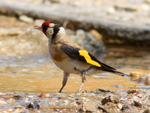 European Goldfinch Carduelis carduelis
European Goldfinch Carduelis carduelis
Resident, breeding The most common nesting finch, feeding on thistles that are plentiful. In winter, birds from the north join the local population.
|
|
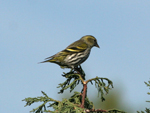 Eurasian Siskin Carduelis spinus
Eurasian Siskin Carduelis spinus
Winter visitor Irregular winter visitor, usually seen every two years in the area. When present, is seen in moderate numbers joining other finches.
|
|
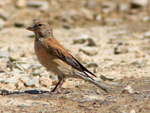 Common Linnet Carduelis cannabina
Common Linnet Carduelis cannabina
Resident, breeding In summer, it frequents open, sparsely vegetated areas, while in winter it can be seen in cultivations along with all the other finches.
|
|
 Hawfinch Coccothraustes coccothraustes
Hawfinch Coccothraustes coccothraustes
Winter visitor Irrgular winter visitor, frequents areas with trees, preferring taller branches.
|
|
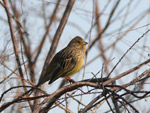 Yellowhammer Emberiza citrinella
Yellowhammer Emberiza citrinella
Accidental Recorded in the past, there are no recent observations.
|
|
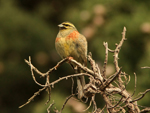 Cirl Bunting Emberiza cirlus
Cirl Bunting Emberiza cirlus
Resident, breeding Scarce resident, found in cultivated areas and the scrubby slopes of nearby hills.
|
|
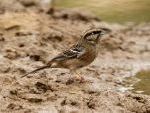 Rock Bunting Emberiza cia
Rock Bunting Emberiza cia
Winter visitor Regular winter visitor, usually found near the wetland and the cultivations. Seen from October to April.
|
|
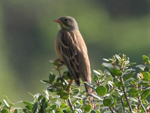 Ortolan Bunting Emberiza hortulana
Ortolan Bunting Emberiza hortulana
Passage migrant 79/409 Directive, Annex I Very rare migrant, with a handful of records. Prefers scrub.
|
|
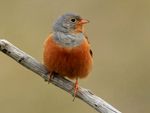 Cretzschmar's Bunting Emberiza caesia
Cretzschmar's Bunting Emberiza caesia
Passage migrant 79/409 Directive, Annex I It is seen in the surrounding hills in scrubby areas, both in spring and autumn.
|
|
 Common Reed Bunting Emberiza schoeniclus
Common Reed Bunting Emberiza schoeniclus
Winter visitor A typical wetland bunting, recorded every year. Frequents almost always near reeds. Recorded from October to March.
|
|
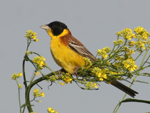 Black-headed Bunting Emberiza melanocephala
Black-headed Bunting Emberiza melanocephala
Summer visitor, breeding Very rare breeder, with just a handful of pairs nesting. Frequents vineyards. Threatened by the conversion of agricultural land and the extensive use of agrochemicals.
|
|
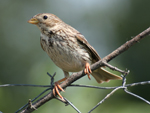 Corn Bunting Emberiza calandra
Corn Bunting Emberiza calandra
Resident, breeding This bird is a scarce breeder, preferring open areas close to the wetland. It is much more common in winter, where flocks numbering hundreds of birds can be seen in cultivated areas.
|



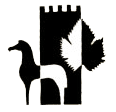

 Mute Swan Cygnus olor
Mute Swan Cygnus olor
 Common Shelduck Tadorna tadorna
Common Shelduck Tadorna tadorna
 Eurasian Teal Anas crecca
Eurasian Teal Anas crecca
 Mallard Anas platyrhynchos
Mallard Anas platyrhynchos
 Northern Pintail Anas acuta
Northern Pintail Anas acuta
 Garganey Anas querquedula
Garganey Anas querquedula
 Northern Shoveler Anas clypeata
Northern Shoveler Anas clypeata
 Common Quail Coturnix coturnix
Common Quail Coturnix coturnix
 Little Grebe Tachybaptus ruficollis
Little Grebe Tachybaptus ruficollis
 Great Crested Grebe Podiceps cristatus
Great Crested Grebe Podiceps cristatus
 Black-necked Grebe Podiceps nigricollis
Black-necked Grebe Podiceps nigricollis
 Cory’s Shearwater Calonectris diomedea
Cory’s Shearwater Calonectris diomedea
 Yelkouan Shearwater Puffinus yelkouan
Yelkouan Shearwater Puffinus yelkouan
 Great Cormorant Phalacrocorax carbo
Great Cormorant Phalacrocorax carbo
 Eurasian Bittern Botaurus stellaris
Eurasian Bittern Botaurus stellaris
 Little Bittern Ixobrychus minutus
Little Bittern Ixobrychus minutus
 Black-crowned Night Heron Nycticorax nycticorax
Black-crowned Night Heron Nycticorax nycticorax
 Squacco Heron Ardeola ralloides
Squacco Heron Ardeola ralloides
 Little Egret Egretta garzetta
Little Egret Egretta garzetta
 Great Egret Egretta alba
Great Egret Egretta alba
 Grey Heron Ardea cinerea
Grey Heron Ardea cinerea
 Purple Heron Ardea purpurea
Purple Heron Ardea purpurea
 Glossy Ibis Plegadis falcinellus
Glossy Ibis Plegadis falcinellus
 Eurasian Spoonbill Platalea leucorodia
Eurasian Spoonbill Platalea leucorodia
 Greater Flamingo Phoenicopterus roseus
Greater Flamingo Phoenicopterus roseus
 European Honey Buzzard Pernis apivorus
European Honey Buzzard Pernis apivorus
 Black Kite Milvus migrans
Black Kite Milvus migrans
 Short-toed Snake Eagle Circaetus gallicus
Short-toed Snake Eagle Circaetus gallicus
 Western Marsh Harrier Circus aeruginosus
Western Marsh Harrier Circus aeruginosus
 Northern Harrier Circus cyaneus
Northern Harrier Circus cyaneus
 Pallid Harrier Circus macrourus
Pallid Harrier Circus macrourus
 Montagu's Harrier Circus pygargus
Montagu's Harrier Circus pygargus
 Eurasian Sparrowhawk Accipiter nisus
Eurasian Sparrowhawk Accipiter nisus
 Common Buzzard Buteo buteo
Common Buzzard Buteo buteo
 Long-legged Buzzard Buteo rufinus
Long-legged Buzzard Buteo rufinus
 Booted Eagle Aquila pennata
Booted Eagle Aquila pennata
 Bonelli's Eagle Aquila fasciata
Bonelli's Eagle Aquila fasciata
 Osprey Pandion haliaetus
Osprey Pandion haliaetus
 Lesser Kestrel Falco naumanni
Lesser Kestrel Falco naumanni
 Common Kestrel Falco tinnunculus
Common Kestrel Falco tinnunculus
 Red-footed Falcon Falco vespertinus
Red-footed Falcon Falco vespertinus
 Eurasian Hobby Falco subbuteo
Eurasian Hobby Falco subbuteo
 Eleonora's Falcon Falco eleonorae
Eleonora's Falcon Falco eleonorae
 Peregrine Falcon Falco peregrinus
Peregrine Falcon Falco peregrinus
 Water Rail Rallus aquaticus
Water Rail Rallus aquaticus
 Spotted Crake Porzana porzana
Spotted Crake Porzana porzana
 Little Crake Porzana parva
Little Crake Porzana parva
 Common Moorhen Gallinula chloropus
Common Moorhen Gallinula chloropus
 Eurasian Coot Fulica atra
Eurasian Coot Fulica atra
 Common Crane Grus grus
Common Crane Grus grus
 Eurasian Stone-curlew Burhinus oedicnemus
Eurasian Stone-curlew Burhinus oedicnemus
 Black-winged Stilt Himantopus himantopus
Black-winged Stilt Himantopus himantopus
 Eurasian Oystercatcher Haematopus ostralegus
Eurasian Oystercatcher Haematopus ostralegus
 Grey Plover Pluvialis squatarola
Grey Plover Pluvialis squatarola
 Northern Lapwing Vanellus vanellus
Northern Lapwing Vanellus vanellus
 Little Ringed Plover Charadrius dubius
Little Ringed Plover Charadrius dubius
 Common Ringed Plover Charadrius hiaticula
Common Ringed Plover Charadrius hiaticula
 Kentish Plover Charadrius alexandrinus
Kentish Plover Charadrius alexandrinus
 Whimbrel Numenius phaeopus
Whimbrel Numenius phaeopus
 Eurasian Curlew Numenius arquata
Eurasian Curlew Numenius arquata
 Black-tailed Godwit Limosa limosa
Black-tailed Godwit Limosa limosa
 Ruff Calidris pugnax
Ruff Calidris pugnax
 Curlew Sandpiper Calidris ferruginea
Curlew Sandpiper Calidris ferruginea
 Temminck’s Stint Calidris temminckii
Temminck’s Stint Calidris temminckii
 Sanderling Calidris alba
Sanderling Calidris alba
 Dunlin Calidris alpina
Dunlin Calidris alpina
 Little Stint Calidris minuta
Little Stint Calidris minuta
 Common Sandpiper Actitis hypoleucos
Common Sandpiper Actitis hypoleucos
 Green Sandpiper Tringa ochropus
Green Sandpiper Tringa ochropus
 Spotted Redshank Tringa erythropus
Spotted Redshank Tringa erythropus
 Common Greenshank Tringa nebularia
Common Greenshank Tringa nebularia
 Marsh Sandpiper Tringa stagnatilis
Marsh Sandpiper Tringa stagnatilis
 Wood Sandpiper Tringa glareola
Wood Sandpiper Tringa glareola
 Common Redshank Tringa totanus
Common Redshank Tringa totanus
 Jack Snipe Lymnocryptes minimus
Jack Snipe Lymnocryptes minimus
 Eurasian Woodcock Scolopax rusticola
Eurasian Woodcock Scolopax rusticola
 Common Snipe Gallinago gallinago
Common Snipe Gallinago gallinago
 Great Snipe Gallinago media
Great Snipe Gallinago media
 Collared Pratincole Glareola pratincola
Collared Pratincole Glareola pratincola
 Caspian Tern Hydroprogne caspia
Caspian Tern Hydroprogne caspia
 White-winged Tern Chlidonias leucopterus
White-winged Tern Chlidonias leucopterus
 Sandwich Tern Sterna sandvicensis
Sandwich Tern Sterna sandvicensis
 Little Gull Hydrocoloeus minutus
Little Gull Hydrocoloeus minutus
 Slender-billed Gull Larus genei
Slender-billed Gull Larus genei
 Black-headed Gull Larus ridibundus
Black-headed Gull Larus ridibundus
 Audouin's Gull Larus audouinii
Audouin's Gull Larus audouinii
 Mediterranean Gull Larus melanocephalus
Mediterranean Gull Larus melanocephalus
 Caspian Gull Larus cachinnans
Caspian Gull Larus cachinnans
 Yellow-legged Gull Larus michahellis
Yellow-legged Gull Larus michahellis
 Rock Dove Columba livia
Rock Dove Columba livia
 Stock Dove Columba oenas
Stock Dove Columba oenas
 Common Wood Pigeon Columba palumbus
Common Wood Pigeon Columba palumbus
 Eurasian Collared Dove Streptopelia decaocto
Eurasian Collared Dove Streptopelia decaocto
 European Turtle Dove Streptopelia turtur
European Turtle Dove Streptopelia turtur
 Great Spotted Cuckoo Clamator glandarius
Great Spotted Cuckoo Clamator glandarius
 Common Cuckoo Cuculus canorus
Common Cuckoo Cuculus canorus
 Barn Owl Tyto alba
Barn Owl Tyto alba
 Eurasian Scops Owl Otus scops
Eurasian Scops Owl Otus scops
 Little Owl Athene noctua
Little Owl Athene noctua
 Tawny Owl Strix aluco
Tawny Owl Strix aluco
 European Nightjar Caprimulgus europaeus
European Nightjar Caprimulgus europaeus
 Common Swift Apus apus
Common Swift Apus apus
 Pallid Swift Apus pallidus
Pallid Swift Apus pallidus
 Alpine Swift Apus melba
Alpine Swift Apus melba
 Common Kingfisher Alcedo atthis
Common Kingfisher Alcedo atthis
 European Bee-eater Merops apiaster
European Bee-eater Merops apiaster
 European Roller Coracias garrulus
European Roller Coracias garrulus
 Hoopoe Upupa epops
Hoopoe Upupa epops
 Eurasian Wryneck Jynx torquilla
Eurasian Wryneck Jynx torquilla
 Greater Short-toed Lark Calandrella brachydactyla
Greater Short-toed Lark Calandrella brachydactyla
 Crested Lark Galerida cristata
Crested Lark Galerida cristata
 Woodlark Lullula arborea
Woodlark Lullula arborea
 Eurasian Skylark Alauda arvensis
Eurasian Skylark Alauda arvensis
 Sand Martin Riparia riparia
Sand Martin Riparia riparia
 Barn Swallow Hirundo rustica
Barn Swallow Hirundo rustica
 Common House Martin Delichon urbicum
Common House Martin Delichon urbicum
 Red-rumped Swallow Cecropis daurica
Red-rumped Swallow Cecropis daurica
 Tawny Pipit Anthus campestris
Tawny Pipit Anthus campestris
 Tree Pipit Anthus trivialis
Tree Pipit Anthus trivialis
 Meadow Pipit Anthus pratensis
Meadow Pipit Anthus pratensis
 Red-throated Pipit Anthus cervinus
Red-throated Pipit Anthus cervinus
 Water Pipit Anthus spinoletta
Water Pipit Anthus spinoletta
 Yellow Wagtail Motacilla flava
Yellow Wagtail Motacilla flava
 Citrine Wagtail Motacilla citreola
Citrine Wagtail Motacilla citreola
 Grey Wagtail Motacilla cinerea
Grey Wagtail Motacilla cinerea
 White Wagtail Motacilla alba
White Wagtail Motacilla alba
 Winter Wren Troglodytes troglodytes
Winter Wren Troglodytes troglodytes
 Dunnock Prunella modularis
Dunnock Prunella modularis
 Rufous-tailed Scrub Robin Cercotrichas galactotes
Rufous-tailed Scrub Robin Cercotrichas galactotes
 European Robin Erithacus rubecula
European Robin Erithacus rubecula
 Common Nightingale Luscinia megarhynchos
Common Nightingale Luscinia megarhynchos
 Black Redstart Phoenicurus ochruros
Black Redstart Phoenicurus ochruros
 Common Redstart Phoenicurus phoenicurus
Common Redstart Phoenicurus phoenicurus
 Whinchat Saxicola rubetra
Whinchat Saxicola rubetra
 Common Stonechat Saxicola rubicola
Common Stonechat Saxicola rubicola
 Isabelline Wheatear Oenanthe isabellina
Isabelline Wheatear Oenanthe isabellina
 Northern Wheatear Oenanthe oenanthe
Northern Wheatear Oenanthe oenanthe
 Black-eared Wheatear Oenanthe hispanica
Black-eared Wheatear Oenanthe hispanica
 Blue Rock Thrush Monticola solitarius
Blue Rock Thrush Monticola solitarius
 Common Blackbird Turdus merula
Common Blackbird Turdus merula
 Fieldfare Turdus pilaris
Fieldfare Turdus pilaris
 Song Thrush Turdus philomelos
Song Thrush Turdus philomelos
 Mistle Thrush Turdus viscivorus
Mistle Thrush Turdus viscivorus
 Cetti's Warbler Cettia cetti
Cetti's Warbler Cettia cetti
 Zitting Cisticola Cisticola juncidis
Zitting Cisticola Cisticola juncidis
 Savi's Warbler Locustella luscinioides
Savi's Warbler Locustella luscinioides
 Eastern Olivaceous Warbler Iduna pallida
Eastern Olivaceous Warbler Iduna pallida
 Olive-tree Warbler Hippolais olivetorum
Olive-tree Warbler Hippolais olivetorum
 Icterine Warbler Hippolais icterina
Icterine Warbler Hippolais icterina
 Moustached Warbler Acrocephalus melanopogon
Moustached Warbler Acrocephalus melanopogon
 Sedge Warbler Acrocephalus schoenobaenus
Sedge Warbler Acrocephalus schoenobaenus
 Eurasian Reed Warbler Acrocephalus scirpaceus
Eurasian Reed Warbler Acrocephalus scirpaceus
 Great Reed Warbler Acrocephalus arundinaceus
Great Reed Warbler Acrocephalus arundinaceus
 Subalpine Warbler Sylvia cantillans
Subalpine Warbler Sylvia cantillans
 Sardinian Warbler Sylvia melanocephala
Sardinian Warbler Sylvia melanocephala
 Rüppell's Warbler Sylvia rueppelli
Rüppell's Warbler Sylvia rueppelli
 Lesser Whitethroat Sylvia curruca
Lesser Whitethroat Sylvia curruca
 Common Whitethroat Sylvia communis
Common Whitethroat Sylvia communis
 Garden Warbler Sylvia borin
Garden Warbler Sylvia borin
 Eurasian Blackcap Sylvia atricapilla
Eurasian Blackcap Sylvia atricapilla
 Yellow-browed Warbler Phylloscopus inornatus
Yellow-browed Warbler Phylloscopus inornatus
 Eastern Bonelli’s Warbler Phylloscopus orientalis
Eastern Bonelli’s Warbler Phylloscopus orientalis
 Wood Warbler Phylloscopus sibilatrix
Wood Warbler Phylloscopus sibilatrix
 Common Chiffchaff Phylloscopus collybita
Common Chiffchaff Phylloscopus collybita
 Willow Warbler Phylloscopus trochilus
Willow Warbler Phylloscopus trochilus
 Goldcrest Regulus regulus
Goldcrest Regulus regulus
 Common Firecrest Regulus ignicapilla
Common Firecrest Regulus ignicapilla
 Spotted Flycatcher Muscicapa striata
Spotted Flycatcher Muscicapa striata
 Collared Flycatcher Ficedula albicollis
Collared Flycatcher Ficedula albicollis
 European Pied Flycatcher Ficedula hypoleuca
European Pied Flycatcher Ficedula hypoleuca
 Eurasian Blue Tit Cyanistes caeruleus
Eurasian Blue Tit Cyanistes caeruleus
 Great Tit Parus major
Great Tit Parus major
 Coal Tit Periparus ater
Coal Tit Periparus ater
 Western Rock Nuthatch Sitta neumayer
Western Rock Nuthatch Sitta neumayer
 Short-toed Treecreeper Certhia brachydactyla
Short-toed Treecreeper Certhia brachydactyla
 Eurasian Penduline Tit Remiz pendulinus
Eurasian Penduline Tit Remiz pendulinus
 Eurasian Golden Oriole Oriolus oriolus
Eurasian Golden Oriole Oriolus oriolus
 Red-backed Shrike Lanius collurio
Red-backed Shrike Lanius collurio
 Lesser Grey Shrike Lanius minor
Lesser Grey Shrike Lanius minor
 Woodchat Shrike Lanius senator
Woodchat Shrike Lanius senator
 Eurasian Jay Garrulus glandarius
Eurasian Jay Garrulus glandarius
 Common Magpie Pica pica
Common Magpie Pica pica
 Hooded Crow Corvus corone
Hooded Crow Corvus corone
 Northern Raven Corvus corax
Northern Raven Corvus corax
 Common Starling Sturnus vulgaris
Common Starling Sturnus vulgaris
 House Sparrow Passer domesticus
House Sparrow Passer domesticus
 Spanish Sparrow Passer hispaniolensis
Spanish Sparrow Passer hispaniolensis
 Eurasian Tree Sparrow Passer montanus
Eurasian Tree Sparrow Passer montanus
 Common Chaffinch Fringilla coelebs
Common Chaffinch Fringilla coelebs
 European Serin Serinus serinus
European Serin Serinus serinus
 European Greenfinch Carduelis chloris
European Greenfinch Carduelis chloris
 European Goldfinch Carduelis carduelis
European Goldfinch Carduelis carduelis
 Eurasian Siskin Carduelis spinus
Eurasian Siskin Carduelis spinus
 Common Linnet Carduelis cannabina
Common Linnet Carduelis cannabina
 Hawfinch Coccothraustes coccothraustes
Hawfinch Coccothraustes coccothraustes
 Yellowhammer Emberiza citrinella
Yellowhammer Emberiza citrinella
 Cirl Bunting Emberiza cirlus
Cirl Bunting Emberiza cirlus
 Rock Bunting Emberiza cia
Rock Bunting Emberiza cia
 Ortolan Bunting Emberiza hortulana
Ortolan Bunting Emberiza hortulana
 Cretzschmar's Bunting Emberiza caesia
Cretzschmar's Bunting Emberiza caesia
 Common Reed Bunting Emberiza schoeniclus
Common Reed Bunting Emberiza schoeniclus
 Black-headed Bunting Emberiza melanocephala
Black-headed Bunting Emberiza melanocephala
 Corn Bunting Emberiza calandra
Corn Bunting Emberiza calandra
